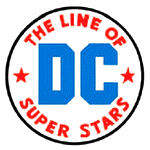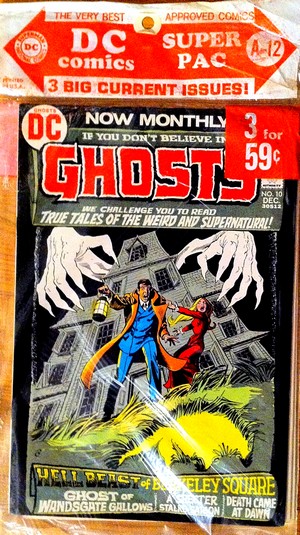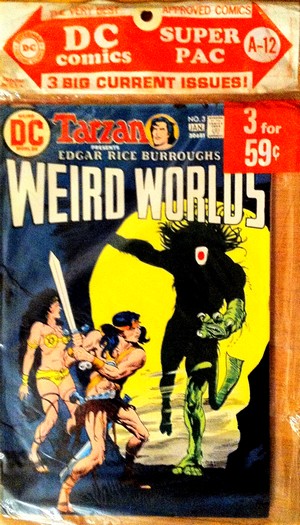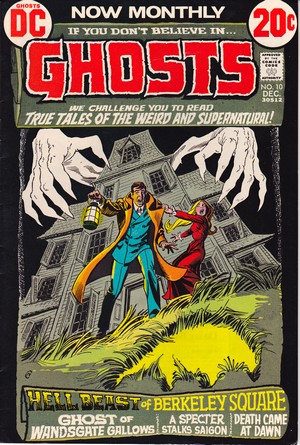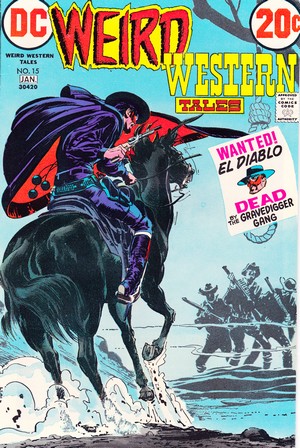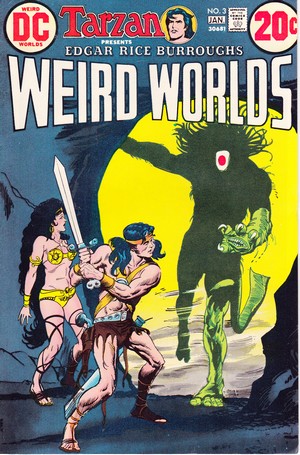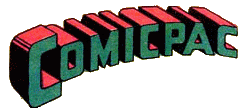GHOSTS, WEIRD WESTERN TALES & WEIRD WORLDS - INSIDE THE |
|||||
 |
|||||
|
|||||
| One in a number of DC's horror anthology titles, Ghosts #10 features stories about a ghostly soldier who tries to warn soldiers to change their plans during the Vietnam War, a man who is haunted by the ghost of the paid murdered who slew his brother and then was hanged for the crime, a sailor who sees a ghastly face and is convinced his boat is doomed, and a house on Berkely Square which is haunted by some evil force. | |||||
Whilst the artwork for this
comic book came predominantly from DC's Philippine talent
pool, the stories were all penned by Leo Dorfman (1914
– 1974), who had started working for DC in the 1950s
as a writer and quickly became a prolific plotter.
Amongst his single-handed creations was Ghosts,
as Paul Levitz recalls:
The stories are rather standard fare, but unlike most horror anthology titles of the 1970s, they are at least not reprints from some 1950s title but original creations, all laid out to the theme of turning sceptical readers into admitting that yes, ghosts do exist... However, in this respect the two one page text features (the first of which is adorned by illustrations) in Ghosts #10 do a far better job, recounting some historical facts of biographies linked to the supernatural. Even if not all the stories live up to the plot suspense they build to start with, it is all in all an entertaining read, also providing some insight into Comics Code restricted horror stories of the Bronze Age. |
|||||
|
|||||
| Weird Western Tales started
out as All-Star Western in 1970. A
straightforward western title to start with, DC adapted
it to conform to the growing demand and success for
horror or supernatural themed comic books. As of issue
#12 it was thus rebranded as Weird Western Tales
- one of a good many DC comic books which would
eventually feature Weird in their title. Editor
Joe Orlando was looking for a catchy main feature and
found that the ghostly El Diablo (starring on the cover
of this issue) didn't quite do the trick, but that the
gritty Jonah Hex made sales roar and would therefore be
given the title's lead for good as of issue #17. He is,
however, absent from this issue. This is, however, more than compensated for by some of the creative talent assembled for the production of Weird Western Tales #15, which showcases early work for DC by Neal Adams (active for DC since 1967) and Marv Wolfman (first professional work for DC in 1968) as well as the pencils of veteran Gil Kane (whose first work for DC went back to 1944). In this sense, Weird Western Tales #15 is a bit of a hidden gem in this Super Pac. Even without Jonah Hex, the stories are quite thrilling - mixing standard wild west lore with a shot of the supernatural works out well and provides for entertaining reading. DC really did invest quite some effort into their non-superhero material, and Weird Western Tales #15 is a good example of the resulting high level quality stories and artwork. Or, as editor Joe Orlando put it on the letters page of Weird Western Tales #15:
The reference to the "Kid titled Western heroes" was, of course, directed at competitor Marvel... Weird Western Tales would eventually run for 8 years and clock up a total of 59 issues, ending with Weird Western Tales #70 in August 1980. |
|||||
|
|||||
| Both stories are
adaptations from novels by Burroughs - The Gods of
Mars (John Carter) and At the Earth's Core
(Pellucidar) - which makes this comic book differ from
most found in 1970s threepack bags: the features are not
self contained but rather parts of ongoing storylines.
This actually made Weird Worlds a
somewhat awkward comic book to have in a Superpac as it
was not at all clear that there would be another Superpac
containing the next issue of the title and thus enabling
buyers to read on with the stories. Chances were: you
were stuck with this segment of a bigger tale. On the other hand it was a fact of life - not only avid comic book readers relying on Superpacs and similar fare to supply them with their favourite reading material would sometimes not be able to get following consecutive issues of a title. In the 1970s, even spinner racks at well stocked newsagent outlets came with no guarantee of an unbroken chain of supply. So you soon learned to deal with that and not be bothered too much by dangling storylines. In the case of Weird Worlds #3 the writing by Wolfman and Wein is so slick that even just getting a slice of the overall story is fun reading. The series' title was partially inspired by the success of Weird War Tales and Weird Western Tales, but didn't really work in this specific case - the title sold poorly in spite of prominent references to Tarzan and Edgar Rice Burroughs, and the end came swiftly after only ten issues in October 1974. |
|||||
| BIBLIOGRAPHY EVANIER Mark (2009) "More on Leo Dorfman", published online in News From Me |
|||||

